Review: Anker PowerCore Fusion 5000 2-in-1 with Dual USB Wall Charger
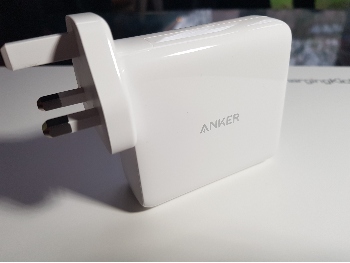
How great would it be to have a charger and power bank in one device? Plug into a socket and charge your mobile phone, then unplug it and still charge your phone on the go. Anker PowerCore Fusion is the device that can do that. Sounds great, isn’t it? How good is it? Is it worth the purchase? Read more to find out.
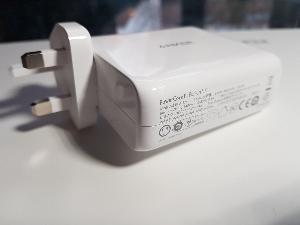
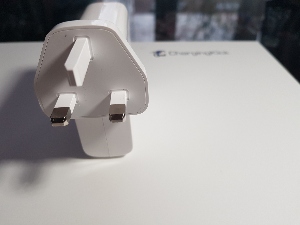
Pros & Cons:
Pros:
Versatility, a charger and a power bank in one device.
Two USB Outputs, UBS-A and USB-C
Simultaneous charging of 2 devices
Cons:
Doesn't charge the internal battery while devices are charged via the Anker PowerCore Fusion
The plugs can’t be changed, unable to use in different countries, primarily considering British and European versions
Long recharging time, nearly 5 hours
Relatively big size for a charger and power bank with 5,000 mAh battery
A small battery, not enough to charge a phone with a big battery, more than 4,000 mAh.
Rating
Power & Performance (1 to 5 stars)
Design & Build (1 to 5 stars)
Technology (1 to 5 stars)
Overall Rating (average of above)
Key Specifications of a Product
Key Specs:
Capacity
4,850 mAh / 17.6 Wh
Dimensions (LxWxH)
4.3 x 3.1 x 1.2 in / 11 x 8 x 3 cm
Weight
6.95 oz / 197 gm
Output & Input Charging:
Average Charging Time of a Mobile Phone (battery capacity 3000mAh)
1 hour and 25 minutes
Average Recharging Time (from 0% to 100%)
4 hours and 45 minutes
Ports:
USB-A Output: 5V/2.4A
USB-C PD Output: 5V/3A, 9V/2A
Charging Technology
Universal Fast Charging Compatibility: Apple Fast Charging; Samsung Fast Charging; USB-C Power Delivery. Only the USB-C port supports fast charging.
Wall Charger & Portable Charger
Pass-Through Charging (Simultaneous charging of 2 devices)
Fast Charging PowerIQ 3.0
A trickle-charging mode is designed specifically to provide safe, stable charging to low-power devices such as Bluetooth earphones and speakers.
Under 100WH
Safe to take on board.
Other Features
18-Month Limited Warranty
Lifetime Technical Support
Ideal For?
Traveler
Businessman
Student
Minimalist
What Inside?
Anker PowerCore Fusion 5000
Protective pouch
Manual in multiple languages
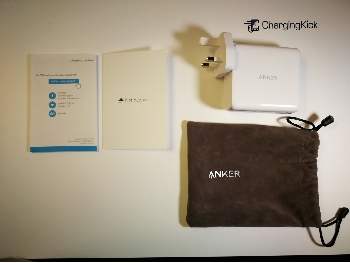
Power & Performance
Battery Capacity
Battery capacity in mAh, and Watts power.
Anker PowerCore Fusion is a small power bank, with a battery capacity of 4,850 mAh / 17.6 Wh.
Considering the size, it’s much bigger than most power banks with this battery capacity. It’s a trade-off you have to make for a 4850 mAh cell inside of the device that allows it to function as a power bank.
Capacity test - discharge the fully charged power bank
Have you ever wondered if the advertised power bank has the claimed battery capacity? Does it really have 5,000 mAh or 10,000 mAh as advertised? It’s possible to check it.
To check the actual battery capacity we need:
The fully charged power bank
A USB tester that shows the current, voltage, mAh, and charging time.
The USB mini adjustable load receives energy from the power bank and releases it safely via the fan. This is the safe way to discharge a fully charged power bank and measure the real battery capacity.
I connect the adjustable load (amperes are set on 2) to the USB tester and then plug it into the fully charged power bank. Once it’s done, now I wait until the power bank’s battery goes flat. The screen on the USB tester will display the Watt-hours and the amount of mAh consumed. These data show the real battery capacity.
Let’s dive deep into the test and result. Following the aforementioned procedure, I tested Anker PowerCore Fusion 5000. Here are the results:
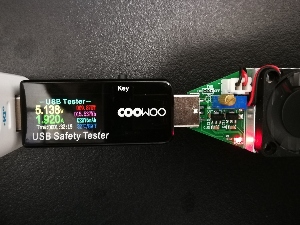
Results
What I found out:
Discharging Time - it took over 1.5 hrs to discharge the power bank.
Watt-Hours - the test yielded 15.5 Wh
Ampere hour - nearly 3,000 mAh was discharged from the power bank.
The real battery capacity is 3,000 mAh. This amount of mAh precisely shows the energy that you will fully use to charge your mobile phone.
Knowing advertised and the actual battery capacity, it’s possible to measure the battery efficiency which is 80%. Manufacturers frequently don’t share this information. Efficiency above 90% is considered a very good one. Anker PowerCore Fusion 5000 can be considered below the average.
Disclaimer: Every test may vary, but only with a small variation.
How many times to charge the most sold mobile phones in 2020?
To put the battery capacity into perspective, I will use a formula for Real Battery Capacity and calculate how many times Anker PowerCore Fusion can charge the top 10 most popular mobile phones in 2020. Perhaps you own one of the enlisted phones or at least you know your mobile phone’s battery capacity. From the previous test, we know the real battery capacity which is 3,000 mAh.
Once you know the real battery capacity, simply divide it by the enlisted mobile phones’ battery capacity to find out how many times it can be charged.
Mobile Phone Model | How Many Times Can It Be Charged? |
4.61 | |
3.05 | |
2.88 | |
2.88 | |
3.24 | |
7.13 | |
2.88 | |
4.13 | |
3.09 | |
2.60 |
As you can see, the tested power bank can fully charge iPhone 12 Pro, iPhone SE 2 and nearly Google Pixel 4a. The rest phones might not get the full charge. However, all phones over 0.75 should get the charge to 90%, since rarely people wait to charge their phones until they reach 0% of battery.
Output Charging
Charging Time & Power Usage
The main purpose of power banks is charging your devices, hence this test cannot be done without testing output charging. The knowledge of the charging time of devices is crucial. Frequently it’s one of the most important factors while purchasing a power bank.
For these tests, I used two mobile phones:
Huawei P10 with a battery of 3200 mAh (Huawei SuperCharge)
Samsung S8 with a battery of 3000mAh (Adaptive Fast Charging)
Both phones support fast-charging technology.
To record data (current, voltage, mAh, time) I used a USB tester.
Real-life examples, test charging phones demonstrate what you can expect after purchasing the power bank.
Anker PowerCore Fusion is a unique device, a wall charger and a portable charger as one, hence it requires testing for both purposes. It has two USB ports: A and C. I used both to find out their efficiency. Below you can find the tests’ results.
Test it as a wall charger via USB-A (Huawei)
%20-%20Finish.jpg?alt=media&token=7dd5178a-c966-407c-ab95-88f5fa0c3bc8)
A standard charging, fluctuating on 5V/1.8A for the majority of the time. It took over 90 minutes to charge Samsung S8 (3,000 mAh). The Anker PowerCore Fusion delivered nearly 2,300 mAh of energy.
Test it as a wall charger via USB-C (Samsung)
%20-%20Finish.jpg?alt=media&token=8a679ac3-e871-4b83-acdf-658d3e5982bf)
The manufacturer claims that USB-C PD has an output on levels 5V/3A and 9V/2A. I had an expectation that charging via USB-C might be faster than via USB-A, but the test shows that charging is on the same level. It charged longer than via USB-A, but in this test the mobile phone’s battery was only 5% when started charging, when in the previous test was 18%. It seems that charging time either via USB-C PD or USB-A will be roughly the same.
Test it as a portable charger via USB-A (Samsung)
%20-%20Finish.jpg?alt=media&token=f44a1660-de88-4494-a848-1f6b3112174c)
A standard charging. It took over 90 minutes to charge Samsung S8 (3,000 mAh). The Anker PowerCore delivered over 2,100 mAh.
Test it as a portable charger via USB-C (Huawei)
%20-%20Finish.jpg?alt=media&token=53124c8a-06a4-42cf-a119-4404335e2051)
Another standard charging on level 5V/1.9A. It took nearly 90 minutes to charge the Huawei P10 (3,200 mAh). It delivered nearly 2,300 mAh of energy.
Round-up of output charging
The Anker PowerCore Fusion is a standard charger, both used as a wall charger and portable charger. During tests, it delivered energy on level 5V/1.9-2A, including USB-C PD, which supposed to deliver energy up to 5V/3A or 9V/2A. It is still a decent result, but it doesn’t meet today’s standard of fast-charging. I expected that the tested device could charge a mobile phone faster once it’s plugged into a USB-C plug.
Input Charging
The Anker PowerCore Fusion as you already know is a unique power bank. Most power banks - if not all of them - are charged via a wall charger. The tested device is different, it must be plugged into a socket. It does make sense since it’s also a wall charger.
The manufacturer claims that the PowerCore Fusion can be fully recharged within two and a half hours. It’s a good time, considering the battery capacity. Let’s find out if it’s true.
Recharging Test 1
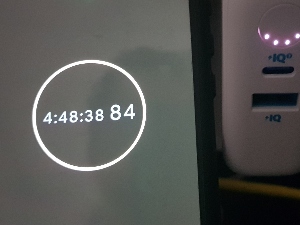
4 hours and 48 minutes! It’s nearly twice longer than the claimed time.
I didn’t want to leave it and I tested again. Perhaps the socket I used wasn’t fully efficient, hence I needed to carry out the second test.
Recharging Test 2
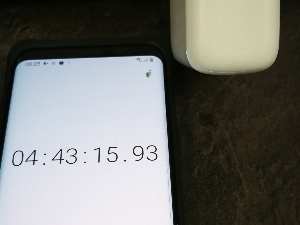
And again! Only 5 minutes less compared with the previous test. In both tests the power bank’s battery was dead and I followed the recommended recharging process. Due to the unusual input charging process, I couldn’t use the USB tester; its data could help to find out the reason.
It’s very disappointing. The battery of 5,000 mAh is a small battery that usually takes no more than 2.5 hours to charge. If you are reading this and you own PowerCore Fusion, share in the comment section what is your time of recharging the device.
Score
Design & Build
Size & Weight
Weight in ounces and grams
6.95 oz / 197 gm
Measurement in inches and centimeters
4.3 x 3.1 x 1.2 in / 11 x 8 x 3 cm
Standard size as a wall charger, but quite big as a portable charger considering its battery capacity. In terms of weight, slightly more than most wall chargers and portable chargers (about 60 grams / 2.1 ounces).
Design & Material
Anker has already got used to their customers to sleek and minimalistic design. Anker PowerCore Fusion isn’t an exception. Available in two colors white and black presents phenomenally.
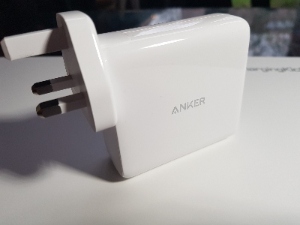

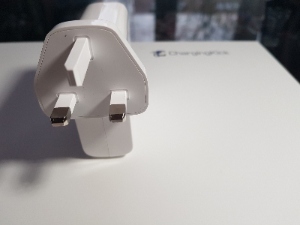
The front-facing side, starting from the top, has 4 blue LED power capacity indicator and two USB ports: USB-C Type (PD compatible) and USB-A Type. On the bottom, you can find the full list of all necessary information about the device e.g. input and output charging.
Made of solid plastic, it’s built very well. Couldn’t find any loose parts. In normal usage, without frequent or/and excessive dropping, the device should last long.
The device’s surface is unnecessarily glossy, it easily leaves fingerprints. The size is about right, stays well in hand.
The American version has a fold-out plug whereas the British and European versions have detachable plugs; which makes it slightly bigger. Sadly, Anker doesn’t sell separate plugs; it would be very convenient for those who travel abroad frequently.
Score
Technology
Ports
Anker PowerCore Fusion 5000 has onboard two USB Ports: USB-C Type (PD compatible) and USB-A Type.
Since you can charge the device only by plugging it into an outlet, both ports are used to charge mobile phones or tablets.
USB-A Output: 5V/2.4A
USB-C PD Output: 5V/3A, 9V/2A
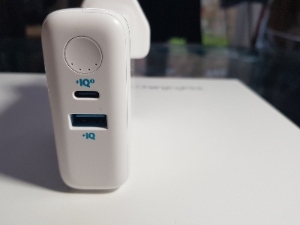
The device charges devices on a standard level but doesn’t meet fast-charging which is becoming today’s norm.
Tech
Anker is one of the trailblazers in charging technology. Most of its devices have onboard the standard technology and frequently the newest solutions. Anker PowerCore Fusion itself is cutting-edge technology, a combination of a wall charger and a power bank. It’s difficult to find a similar device on the market.
The device has the undermentioned technologies:
Universal Fast Charging Compatibility: Apple Fast Charging; Samsung Fast Charging; USB-C Power Delivery. Only the USB-C port supports fast charging.
Wall Charger & Portable Charger
Score
Conclusion
Overall Opinion
When I came across the Anker PowerCore Fusion I thought I will finally replace my charger and have extra spare energy to charge my phone on the go. As a minimalistic person, having only essentials, I thought it would keep my things to the minimum. Having said that, it could have sorted this issue, but large size, small battery capacity, slow recharging speed and inability to change plugs drifted me away from this product. It has amazing potential and I would love to see an improved version. I am certain many people will find this device useful who have smaller demands than me.